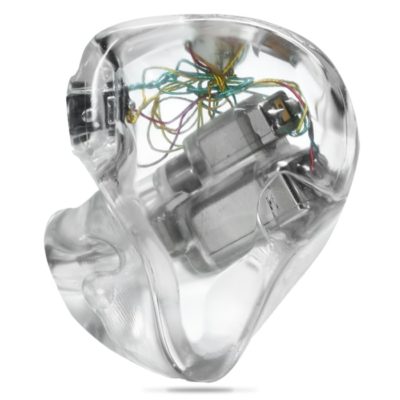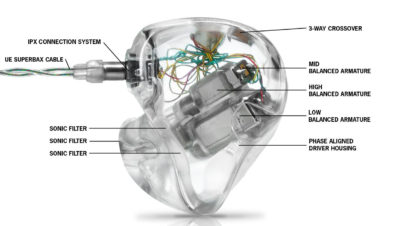New Gear Review: Reference Remastered In-Ear Monitors by Ultimate Ears

Ultimate Ears, in partnership with Capitol Studios, deliver the Reference Remastered in-ear monitors—are they the right fit for you?
Typically, when we think of in-ear monitoring, we think of live sound applications: musicians on stage, DJs hyping up crowds and the like.
Ultimate Ears however, in partnership with Capitol Studios, aims to “remaster” our thinking with a product custom-designed for audio engineers, music producers, and others who are looking for detailed and accurate listening—even for those working with hi-res audio.
The Ultimate Ears Reference Remastered in-ear monitors mark the company’s second collaboration with Capitol Studios, which is known in for an impressive history of major recordings, including hi-res productions. These in-ear monitors make use of Ultimate Ears’ own proprietary cutting-edge 3D ear scanner technology in order to create an altogether different custom fitting experience than anyone has previously had. Let’s take a closer look at the Reference Remastered in-ear monitors and see what they’re all about.
Features
The Reference Remastered in-ear monitors have a frequency range of 5Hz-25kHz, with a flat response up to 18kHz. Boasting a noise isolation rating of up to -26dB, these units utilize Ultimate Ears’ proprietary True Tone Drivers to extend the frequency range, making a perfect partnership for them and hi-fi experts Capitol Studios.
If you are a fan of hi-res, or utilize/work in this medium, these in-ears will help accurately represent frequencies and overtones that would otherwise be absent. What many may not realize about custom-molded in-ear monitoring is that it allows for natural ambient sound occlusion. This means that the fit of the molds sits within your ear’s natural frequency curve to allow as close to natural, accurate, and isolated listening as possible.
These monitors can also be plugged in via adaptor to any interface. Listening at a very low volume is possible, and makes for more accurate and healthy listening habits—a crucial measure to take during long hours of focused work, and to maintain hearing health.
Each pair allows for a whole host of user customization, with choices for things like color, back plate options, and high-quality cable length and type (add an additional cable with mic clicker for $100; cables can be swapped out with any compatible 3rd party high-quality cable). Additionally, the Reference Remastered monitors ship with a choice of hard case types and options for initials on the monitors themselves, as well as the owner’s name on the case.
Ultimate Ears’ own proprietary 3D ear scanner was in development for 6 years leading up to its use with retailers. The fitting process involves taking digital images of the ear and canal, which takes less than 10 minutes, and then having them custom printed via 3D printing. Once the ear is scanned, the files are uploaded on a computer and can quickly be shared with the production team. From there, the housing of the custom molds can be built.
Such a process allows someone like myself to have images (rather than impressions) taken of their ears, which bypasses the strange ear foam process and the trip to the audiologist. This makes fittings more accessible for musicians on tour, or those working remotely.
In Use
I found the Reference Remastered monitors to be a comfortable fit. I was concerned that because they are a hard-shell plastic they would be uncomfortable to wear, but I was pleasantly surprised. I was also worried that getting the molds to fit in my ears would be difficult, but I am relieved to say I was wrong. (The non-molded ones that I had tried on at NAMM were not an easy fit, so if you test out a generic pair, do trust that the molds make a world of difference.) They were a perfect and easy fit for this Cinderella’s ears.
I reviewed recordings of my own material, recordings of bands that I am currently working with, and several mixes that were just returned to me, and I am happy to say it was an extremely refreshing experience. I was amazed at how my ears had adjusted to exaggerated bass, muddy mids, and other skewed playback. I had become accustomed to listening in consumer grade non-molded ear buds, so it took a minute for my ears and brain to adjust to such clarity.
I then spent time listening to recordings I know inside and out—imperfections, chair squeaks and all… I was shocked to hear a page turn I had never noticed before (possibly due in part to the extended and accurate high frequency range now accessible to my ears!).
The isolation that the Reference Remastered in-ears offer is very useful, especially for professionals who have to travel but still need accurate and detailed monitoring. Some of my listening tests were conducted in bustling airport gates, and the monitors still provided studio-like detail, enabling me to make notes for clients. In my home studio, I was able to apply them to my own work and evaluate some of my EQ choices. In this setting, playback was perhaps more accurate than my room itself would have allowed (like many of us, I sometimes work in rooms that aren’t perfectly treated).
It was nice to have the option of being able to take my room out of the equation completely. Furthermore, since these are meant for high-resolution audio, it was a benefit to have access to the extended frequency range when reviewing sessions that are in 24/48 or higher.
In addition, I tested out different cable sets and found this extremely easy, and also developed a great fondness for the included hard case since I have been traveling with them.
To Be Critical
As mentioned above, the in-ears are a comfortable fit, but do be aware that you may have a difficult time getting them out of your ears in a hurry (especially if someone, say in an airport, suddenly wants to speak to you). They, like many molded in-ears, are definitely easier to apply than to remove.
The seal that the monitors create is very good, although I found myself wondering how the fit would compare to the traditional molding method that uses foam injections. Currently my only basis for comparison is a pair of custom-molded filtered ear plugs that were done by traditional foam injection, which are also made of a different soft rubber material. The fit is without a doubt comparable, and it should be noted that musicians shouldn’t try to substitute their monitors as hearing protection, as they may not be as effective.
I found that once the monitors are in your ears, the cable attaches near the front/top of the mold, lateral with your temple, which then has to be wound up and over the top of the ear. This is the common fit/design for most in-ears, regardless of manufacturer. The cable can then be tucked behind the ear, and if you wish, can even be fastened snugly to the back of the head.
If you have longer hair this can be a bit trying, and also makes the in-ears complicated to remove in a hurry. I wouldn’t mind seeing future models where the cable sits differently so that it doesn’t need to be wound around the back of the ear. This, I understand is not the norm, and a minor detail considering the precision, benefits, and excellent design of these monitors.
Summing it Up
If you need pinpoint accuracy and detailed monitoring on-the-go or in the studio, or if you work with hi-res audio, Ultimate Ears’ Reference Remastered in-ears are an excellent option. Features aside, investing in proper hearing protection is worth the price of admission alone.
The Reference Remastered monitors start at $999, with additional customization available (some additional charges may apply for certain options). Let it be known that these are not your average in ear monitors, and they are not for your average listening… but who wants to be average anyway?
Kallie Marie is a producer, composer and educator who lives in New York.
Please note: When you buy products through links on this page, we may earn an affiliate commission.








[…] Ultimate Ears however, in partnership with Capitol Studios, aims to “remaster” our thinking with a product custom-designed for audio engineers, music producers, and others who are looking Read more… […]